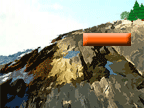 |
 |
|||||||||||||||
|
An important behavioral adaptation of the rough periwinkle is its ability to maintain its position in the rocky intertidal. If the snail is knocked loose from its position in the upper intertidal, it will migrate back to the area. In its upward migration, the snail must contend with a bewildering variety of obstacles, such as vertical rock surfaces and deep crevices. Using the diagram above, follow along as we track the migration of the snail. When right side up, the snail climbs up vertical surfaces. When right side up and confronted with a crevice, the snail reacts negatively toward light causing it to move deeper into the dark crevice. Once the snail has moved from the lower to the upper surface of the crevice, it is now upside down. It then reacts positively toward light, which brings it out of the crevice. Once outside the crevice the snail is ready to climb the next vertical surface. By responding to obstacles in this method, the snail will eventually reach its former position in the upper intertidal area. (Described by R.C. Newell, 1970, The Biology of Intertidal Animals, Elsevier) |
||||||||||||||||
|
||||||||||||||||
|
||||||||||||||||


